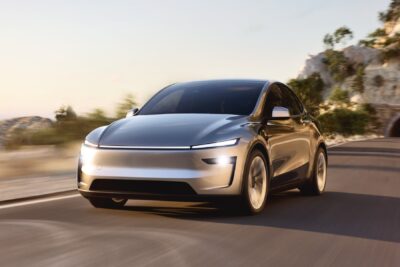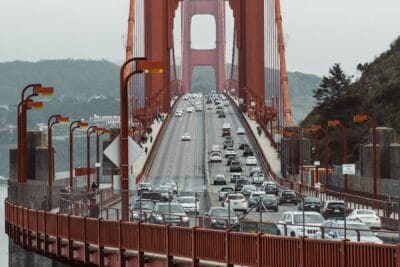EU Commission presents ‘Fit for 55’ climate package
The EU Commission has presented its ‘Fit for 55’ climate package. It contains legislative initiatives with which the Commission wants to achieve the goals of the ‘Green Deal’. Crucial for the car industry: CO2 emissions from new cars are to be reduced to zero by 2035, which would mean the end of petrol and diesel.
In concrete terms, the Commission has presented twelve legislative initiatives, eight of which are updates of existing laws. In addition to the targets for cars, the focus is on a tightening of emissions trading. With the ‘Green Deal’ – and the reduction of CO2 emissions by 55 per cent by 2030 compared to 1990 as an intermediate step – Commission President Ursula von der Leyen wants to make Europe the first CO2-neutral continent. “Our economy, which is based on fossil fuels, has reached its limits,” von der Leyen said at the presentation of the climate package. “CO2 must have a price. This price must be so high that people choose the clean and environmentally friendly solution.”
For the mobility sector, two initiatives are central. The first is to establish a separate emissions trading system for fuels used in transport and buildings. According to the Commission, this is intended to “counteract the lack of emission reductions in road transport and buildings” – the transport sector has famously not only made no CO2 savings it has actually increased emissions.
There are no details on this yet, but the screws are also to be tightened on the well-known emissions trading system for emissions from power generation and energy-intensive industries: The Commission proposes to lower the cap and increase the annual reduction rate.
As a “complement to emissions trading” for road transport, there are to be stricter CO2 emission standards for cars and vans. As reported in advance by some media, the Commission has decided on the de facto phase-out of internal combustion vehicles from 2035: Officially, CO2 emissions from new cars are to be reduced by 100 per cent by then – in other words, to zero. As an interim target for 2030, the EU Commission proposes a 55 per cent reduction compared to 2021.
Compared to the current 37.5 per cent, the 55 per cent are a tightening, but the CO2 reduction target for 2030 has not turned out to be quite as high as was previously under discussion. Observers see this as a classic compromise in which Commission Vice-President Frans Timmermans seems to have prevailed: Timmermans wanted 2035 for the end of combustion cars, other Commissioners 2040 at the earliest. Since the Commission decides unanimously, there was a deal with 2035, but a reduced interim target for 2030.
Nevertheless, a reduction of 55 per cent compared to the 95 grammes of CO2 per kilometre valid for 2021 means that the target value for 2030 is less than 43 grammes of CO2 per kilometre. In view of the developments over the last couple of years, this will hardly be possible with purely combustion engines – especially since it is already becoming apparent that the industry will hardly develop new and economical engines from scratch. The engines that exist today will be further developed and electrified to a certain extent in order to achieve the 43 grams.
20 Gigafactories by 2030?
The fact that the compromise was reached rather late in this form is also shown by a publication by the consulting firm McKinsey. The consultants had already sent out the first reaction shortly before the presentation in Brussels – and had still assumed a reduction target of 60 per cent by 2030.
Since the figures are nevertheless correct, with a slight deviation, here are the core statements in brief: A 60 per cent reduction in CO2 emissions from new cars by 2030 would have meant that almost 70 per cent of new sales and 25 per cent of existing vehicles would have to be electric in the target year. Around six million public charging points would be needed for these vehicles in 2030, and more than 10,000 charging points would have to be installed every week from now on – McKinsey does not distinguish between AC, DC and HPC here. To build all these cars, around 20 gigafactories would have to be built in Europe – and 600 GWh of battery cells produced. Electricity demand in the EU would increase by five per cent. By the way, VW’s chief technology officer Thomas Schmall says he rather expects an industry-wide demand for 30 battery factories in Europe.
In an interview with the Handelsblatt, Timmermans reiterated that there would be no formal ban on petrol and diesel cars. “We are now setting a date by which new cars and vans will have to be emission-free,” said the Commission Vice-President. “Some in the car industry claim that cars with internal combustion engines can also be emission-free. I think that’s quite a challenge, to put it very mildly.”
Charging point expansion to be enshrined in AFID rewrite
There was probably no profound change in the targets for charging infrastructure development: Under the revised AFID (Alternative Fuels Infrastructure Directive), member states are to be obliged to build a reliable network throughout Europe. A fast-charging station is to be built every 60 kilometres along the motorways and a hydrogen filling station every 150 kilometres for heavy transport – on this point, the preliminary reports have proven to be accurate. “This regulation ensures that there is sufficient public charging capacity in each Member State to meet the needs of the larger fleet of zero-emission cars that will come on the market, including under the revised CO2 standards,” the Commission said. AFID will also regulate access to electricity for ships, barges and aircraft at major ports and airports.
In a Q&A, the Commission gives some more details on how the fleet transformation and infrastructure development will take place. By 2030, “at least 30 million electric cars” are expected to be reached. There should be one million charging points by 2025 and 3.5 million by 2030. For the charging stations along the motorways, 300 kW per location must be available by 2025 – with “at least 150 kW”, so probably two charging points with this power. By 2030, there should be 600 kW – i.e. four charging points with 150 kW each. “Fleet-based targets” are to ensure that 1 kW of charging capacity is installed for every battery-powered electric car registered in a member state. In other words: if the number of registrations of electric cars increases more quickly, the expansion of charging must also proceed more quickly.
The Q&A also mentions targets for battery-electric trucks. Here, charging points with 1.4 MW are to be provided every 60 kilometres along the motorways by 2025, and 3.5 MW by 2030. In addition, as mentioned, there is to be a hydrogen filling station for light and heavy commercial vehicles every 150 kilometres.
Whether all the goals of the EU Commission – also for the other sectors – will be implemented in this way is still open. First of all, the directives, like AFID, must be adopted by the EU Parliament – amendments are possible. The directives are framework laws of the EU, they must then subsequently be transposed into national law by the member states and their parliaments – in practice a process that takes years.
With reporting by Sebastian Schaal, Germany.
ec.europa.eu (announcement), europa.eu (Commission proposal of the AFID amendment as PDF), europa.eu (Q&A), handelsblatt.com (interview with Timmermans in German)





1 Comment